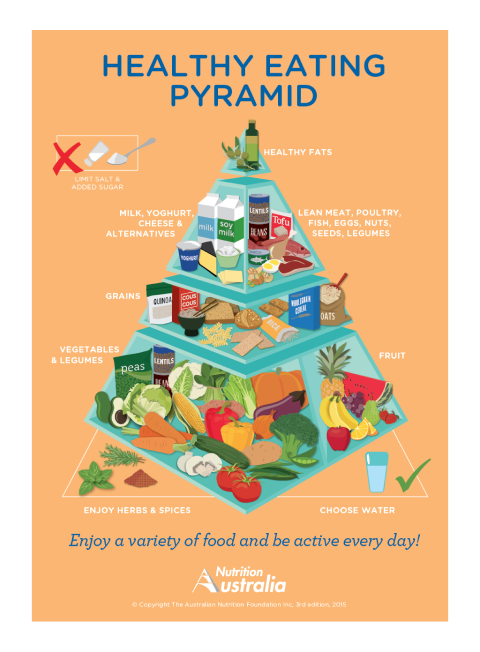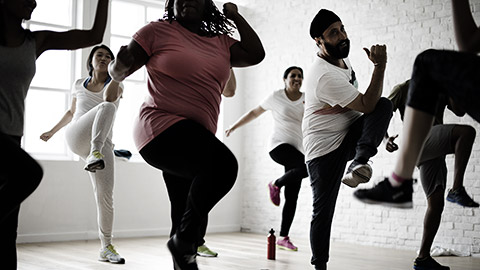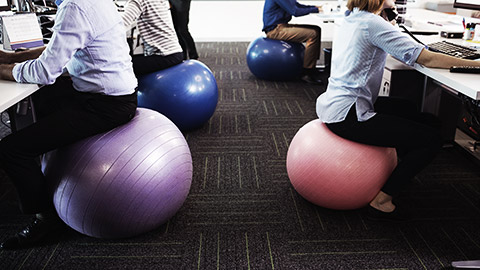In this section you will learn to:
- Review factors that contribute to maintenance of a healthy body
- Enhance quality of work activities by using and sharing information about healthy functioning of the body
Supplementary materials relevant to this section:
- Reading I: Cardiovascular Risk & Obesity
- Reading J: Sleep Matters
In the previous section of this unit, you were introduced to the relationships between different body systems and how they unite to support the healthy functioning of the body. However, for these body systems to be healthy and function thoroughly, we as humans need to perform and conduct specific duties to support their functioning. This section of the module looks at what we need to do, in order to maintain a healthy functioning body and in line support the body systems.

By now, it should be apparent that human health depends on a diet consisting of many different nutrients; proteins, carbohydrates, fats, water, vitamins, minerals, and various beneficial chemicals.
To acquire all of these nutrients, it is important to consume a variety of foods. Nutritionists use the term balanced diet to describe the ideal food intakes required to supply your cells, tissues, and organs with the nutrients needed to maintain proper function.
A balanced diet
We need food for three main reasons:
- To supply us with a fuel for energy
- To provide materials for growth and repair of tissues
- To help prevent disease and keep our bodies healthy
The food that eats is called our diet. No matter what you like to eat, if your body is to work properly and stay healthy, your diet must include carbohydrates, lipids, protein, minerals, and vitamins, as well as dietary fibres and water.
Food should provide you with all of these things, but it is important to ensure your diet includes the right amount of each substance. A diet that provides enough of these substances and in the correct proportions to keep you healthy is called a balanced diet.
The Healthy Eating Pyramid is a simple visual guide to the types and proportion of foods that we should eat every day for good health. It contains the five core food groups, plus healthy fats, according to how much they contribute to a balanced diet based on the Australian Dietary Guidelines (2013). The layers of the Pyramid are based on the recommended food intake for 19–50-year-olds according to the Australian Dietary Guidelines (2013). However, the proportions and placement of each food group are generally applicable to all age groups from 1–70 years.
Tip
Find out more.
The Australian Dietary Guidelines recommend the number of standards serves we should consume from the five food groups each day, for a nutritious and balanced diet.
The recommended intake amounts differ by age, gender and life stage.

The major food groups
- Carbohydrates are one of the body’s main sources of energy, and many nutritionists recommend that approximately 45–65% of our calorie intake come from carbohydrates. Carbohydrates may be either simple or complex. Simple carbohydrates (sugars) are found in many natural foods such as fruits, some vegetables, and honey.
- Lipids (fats) - are essential components of every living cell. Fat stores energy and several vitamins, cushions organs, and insulates the body under the skin.
- Proteins – They make up the enzymes that direct metabolism, they serve as receptor and transport molecules, and they build our muscle fibres. A few are hormones.
- Vitamins - Vitamins are organic compounds (other than carbohydrate, fat, and protein) that the body uses for metabolic purposes but is unable to produce in adequate quantity. Vitamins fall into two groups: fat soluble and water soluble. Fat-soluble vitamins are absorbed more readily if there is fat in the diet. Water soluble vitamins are absorbed more readily than fat soluble vitamins, but they are stored briefly and rapidly excreted in urine.
Energy and calories
Even while you are asleep you need a supply of energy – in order to keep warm, for your heart to keep beating, to allow messages to be sent through your nerves, and for other body functions. However, the energy you need at other times depends on the physical work you do. The total amount of energy that a person needs to keep healthy depends on their age and body size, and on the amount of activity they do. It also depends on the climate they live in. People in cold countries need more energy to maintain their body temperature.
| Age/sex/occupation of person | Energy needed per day/kJ |
|---|---|
| Newborn baby | 2000 |
| Child aged 2 | 5000 |
| Child aged 6 | 7500 |
| Girl aged 12-14 | 9000 |
| Boy aged 12-14 | 11000 |
| Girl aged 15- 17 | 9000 |
| Boy aged 15-17 | 12000 |
| Female office worker | 9500 |
| Male office worker | 10500 |
| Heavy manual worker | 15000 |
| Pregnant women | 10000 |
| Breast-feeding women | 11300 |
Reading
Reading J: Cardiovascular Risk and ObesityReading J provides an overview of the mechanisms of obesity and its relation to cardiovascular risks, describing the available treatment to manage this condition.

Regular aerobic exercise strengthens the heart muscle and reduces the resting heart rate and blood pressure. It has also been shown to increase the number of red blood cells in the body, helping with the transport of oxygen. Aerobic exercise does not only benefit the cardiovascular system; it also improves a person’s overall fitness in many ways. It:
- helps maintain a healthy body weight, to prevent obesity
- reduces the levels of lipids, including cholesterol, in the blood
- builds skeletal muscle, increasing the mass and ‘tone’ of muscles
- improves the strength of tendons and ligaments
- strengthens the diaphragm and intercostal muscles and increases the vital capacity of the lungs, so that breathing is more efficient
- stimulates the immune system
- helps maintain the level of glucose in the blood, which reduces the risk of type 2 diabetes
- reduces the risk of contracting certain cancers, such as colon cancer
- makes people feel happier and more satisfied with life – some studies have even shown that regular exercise is as good as many medicines in treating
- depression
Exercise instead of driving

Cars reduce how much we walk. Suggestions instead of driving include:
- Walk to the corner shops instead of driving.
- Cycle to work one or two days every week.
- Walk to the bus stop or train station and catch public transport to work.
- If taking the bus or tram, get off one stop early and walk the rest of the way.
- Park the car a distance from the entrance of the shops and walk, rather than parking right out the front.
- Wash and vacuum the car yourself instead of taking it to a car wash.
Exercise in the workplace

Suggestions include:
- Take the stairs instead of the lift or escalator.
- Make your next meeting a walking meeting or at least a standing meeting.
- Use at least half of your lunch break for a brisk walk, even if it is only 10–15 minutes.
- Stretch at your desk.
- When you need to talk to a colleague, do not use the phone or internal email – get up from your desk and walk over to them.
- If your job involves sitting at a desk all day, make sure you get up and walk around for a few minutes every hour.
Passive exercise at home
Suggestions include:
- Listen to your favourite music or the radio and dance around the house.
- Play actively with your children.
- Walk the dog more often or make your usual walk 10 minutes longer.
- Get stuck into your garden. Mow, rake leaves and get some planting done.
- Incorporate a few more physical activities into your family’s leisure time. For example, you could take the children to the park or kick a ball around the backyard.
Tip
Find out more
This booklet is designed to help older Australians achieve sufficient physical activity for good health as they age. It is mainly for people who are not currently building 30 minutes of physical activity into their daily lives and are looking for ways they can do so. (Recent surveys show about half of all older Australians are not doing at least 30 minutes of physical activity a day).
Mental illnesses are health conditions that involve abnormal changes in a person’s thoughts, emotions, or behavior. These changes cause distress or problems in functioning in family, work, or social situations. Mental illness is quite common.
The recommended activities would be:
- reading
- taking a stroll around a park
- learning new skills
- avoiding alcohol and other substances
- playing games that would stimulate the brain (chess, puzzles, crosswords)
Over 2 in 5 (44%, or 8.6 million) Australians aged 16–85 is estimated to have experienced a mental disorder at some time in their life, with 1 in 5 (21%, or 4.2 million) having experienced a mental disorder in the previous 12 months.
Anxiety disorders (such as Social Phobia) are the most common type of disorder, affecting 1 in 6 (17%, or 3.3 million) Australians, followed by Affective disorders (such as Depressive Episode) (8%), and substance use disorders (such as Alcohol Dependence) (3. %).
Almost 1 in 7 (14%) children and adolescents aged 4–17 years are estimated to have experienced a mental illness in the previous 12 months.
Five percent or 800,000 people are estimated to have a severe mental illness, of which 500,000 people have episodic mental illness and 300,000 have persistent mental illness.
Mental and substance use disorders were the second largest contributor (24%) of the non-fatal burden of disease in Australia.
(Australian Institute of Health & Welfare, 2022)
Sleep is an orderly process regulated by the brain. The central aspects of the process are decrease in awareness of external signals and of physical activity, renewal of the brain’s sources of energy, and the processing of acquired information. Today, sleep deprivation is common in developed nations, with the average adult sleeping for only six or seven hours each night. The Sleep Health Foundation recommends that adults should aim for 7–9 hours of sleep per night.

Most of us feel that we haven’t had enough sleep at least some of the time. It is thought that sleepiness causes about one in six road accidents.
| Age | Recommended | May be Appropriate | Note Recommended |
|---|---|---|---|
| Newborns 0-3 months | 14 to 17 hours |
|
|
| Infants 4-11 months | 12 to 15 hours |
|
|
| Toddlers 1-2 years | 11 to 14 hours |
|
|
| Preschoolers 3-5 years | 10 to 13 hours |
|
|
| School-aged Children 6-13 years | 9 to 11 hours |
|
|
| Teenagers 14-17 years | 8 to 10 hours |
|
|
| Young Adults 18-25 years | 7 to 9 hours |
|
|
| Adults 26-64 years | 7 to 9 years |
|
|
| Older Adults >= 65 years | 7 to 8 hours |
|
|
The most common distractions from sleep are:
- the internet
- texting and social media
- parenthood
- shiftwork
- travel across time zones
- illness
- poor sleeping habits
- some medications.
Reading
Reading K: Sleep Matters
The aim of Reading M is to raise awareness about the importance of sleep and its crucial role for our health, both physical and mental, just like diet and exercise.
Regular health check-ups can identify any early signs of health issues. Finding problems early means that your chances for effective treatment are increased. Many factors, such as your age, health, family history and lifestyle choices, impact on how often you need check-ups.
One of the best ways to prevent future illness is to keep up to date with regular health checks and early detection programs such as cancer screenings, regular immunisations, and tests for blood borne viruses and sexually transmitted infections.
Regular cancer screening saves lives and early detection leads to better outcomes for cancer treatments. Some types of cancer can be detected before symptoms appear, and screening can also find changes in cells before they become cancer.
There are three world-leading population-based cancer screening programs in Australia:
- Cervical screening every five years for women aged 25 to 74, subsidised by Medicare
- Breast screening – or mammograms – provided free every two years for women aged 40 to 74 years
- Bowel screening tests – a free, easy, at-home test posted to people aged 50 to 74 every two years.
(Department of Health & Aged Care, 2022)
You can do a basic health check at home to review your health in relation to:
- Alcohol – people who have at least 2 alcohol-free days per week and stick to no more than 2 standard drinks per drinking day have better long-term health.
- Dental care – cleaning your teeth regularly and eating a low-sugar diet can reduce your risk of tooth decay, gum disease and tooth loss. Visit a dentist or other oral health professional at least once a year for a dental examination and professional cleaning, or more frequently as advised by your dentist.
- Diet – a healthy diet improves your general health and wellbeing. Have at least 2 serves of fruit and 5 serves of vegetables each day.
- Physical activity – regular physical activity is good for your mental health, heart and bones, and can prevent many diseases. Aim for 30 minutes to an hour of moderate physical activity a day. Moderate physical activity takes some effort, but still allows a conversation to be held (for example, brisk walking, gentle swimming, social tennis).
- Skin checks – check your skin regularly for unusual moles or freckles and see your doctor if you notice anything unusual. People who work outdoors need a yearly examination by their doctor or a dermatologist.
- Smoking – smoking increases your risk of many diseases, including heart disease, stroke, lung disease and thin bones. If you smoke, quitting as soon as possible helps reduce the harm.
- Weight – maintaining a healthy weight range helps prevent longer-term diseases, such as diabetes and arthritis.
This section of the module reviewed the factors that contribute to the maintenance of a healthy body. You also learned about enhancing the quality of work activities through exercise and regular, recommended health check-ups.
